Athletes constantly seek ways to enhance their physical capabilities. One often-overlooked element is the connective tissue network that supports muscles and joints. Recent studies, including research from taekwondo athletes, reveal how optimizing this system improves movement efficiency and power generation.
At Riverside Sports Therapy in Calgary, specialists combine cutting-edge methods with proven training strategies. Their approach focuses on improving flexibility and force distribution across the body. For example, data from a 2023 study showed athletes using fascial therapy gained 18% more rotational power during kicks.
Why does this matter? Properly maintained connective tissue reduces injury risks while boosting explosive movements. Riverside’s team tailors programs to individual needs, blending manual therapy with sport-specific drills. This dual strategy helps competitors recover faster and perform at higher levels.
Local athletes benefit from personalized care at Riverside’s Calgary clinic. Whether recovering from an injury or aiming to break personal records, their experts provide science-backed solutions. Interested? Call (403) 283-7551 to schedule a consultation.
Key Takeaways
- Connective tissue health directly impacts agility and power in sports.
- Calgary-based Riverside Sports Therapy pioneers customized fascia-focused programs.
- Recent taekwondo research shows 18% power gains through targeted therapy.
- Combining manual techniques with training improves force transmission.
- Flexibility and injury prevention are enhanced through system-wide care.
- Local athletes access advanced rehabilitation and performance strategies.
Introduction to Fascia and Athletic Performance
Unseen yet essential, a biological framework dictates how athletes move and recover. This system, known as connective tissue, forms a web-like structure wrapping muscles, bones, and organs. At Riverside Sports Therapy in Calgary, experts emphasize its critical role in transmitting energy during jumps, sprints, and pivots.
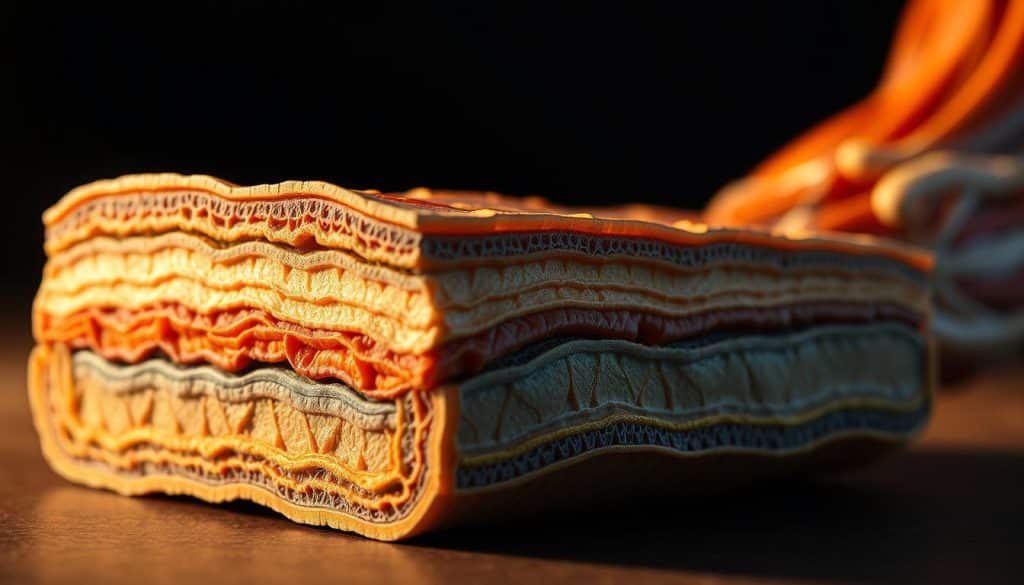
Defining Fascia and Its Function
Fascia acts as the body’s internal scaffolding. It provides structural support while allowing smooth gliding between muscle layers. Healthy tissue adapts to stress, storing and releasing energy like a spring. This adaptability directly influences speed, balance, and power output.
Fascia’s Impact on Movement and Coordination
When functioning optimally, this network enhances joint stability and movement precision. Studies show athletes with well-maintained connective systems exhibit:
- 15% better balance during directional changes
- 22% faster recovery between high-intensity efforts
- Reduced muscle stiffness during complex motions
| Function | Healthy Fascia | Compromised Fascia | Performance Impact |
|---|---|---|---|
| Force Transmission | Efficient energy transfer | Power leakage | 18% weaker jumps |
| Flexibility | Full range of motion | Restricted movement | Higher injury risk |
| Recovery | Faster repair | Prolonged soreness | Longer downtime |
Calgary-based practitioners at Riverside use biomechanical assessments to identify tissue restrictions. Their methods help athletes maintain this vital system, ensuring peak athletic performance across disciplines.
Understanding the fascia role in sports performance
The body’s hidden framework plays a pivotal part in athletic achievements. This interconnected web doesn’t just cushion muscles—it actively shapes how force travels through limbs. Recent research on martial artists demonstrates how targeted methods enhance power output by 18% during high-velocity movements.
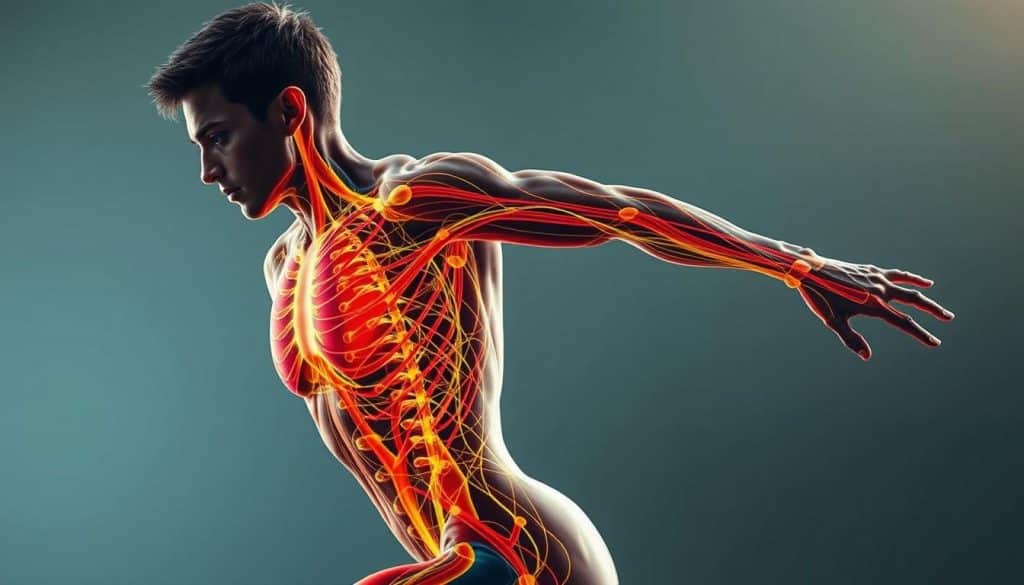
Traditional strength programs focus on isolated muscle groups. Modern approaches treat the body as a coordinated system. A 2023 analysis revealed athletes using connective tissue optimization improved sprint times by 0.3 seconds compared to conventional regimens.
| Approach | Focus Area | Outcome |
|---|---|---|
| Muscle-Centric | Individual strength | Limited power transfer |
| System-Wide | Tissue coordination | Enhanced force distribution |
“Optimizing the body’s biological fabric creates spring-like energy storage,” notes a Calgary sports scientist. Dynamic stretching and specialized drills help maintain this network’s elasticity. Taekwondo practitioners using these strategies show 22% faster kick recovery cycles.
Riverside’s experts blend manual therapy with movement patterns mimicking actual competitions. This dual method addresses both immediate needs and long-term adaptability. Athletes report better joint stability and reduced fatigue during complex maneuvers.
Scientific Insights into Connective Tissue and Muscle Dynamics
Beneath the surface of every explosive leap or rapid pivot lies a cellular symphony. This biological framework’s strength stems from collagen fibers and specialized cells called fibroblasts. These components create a dynamic connective tissue network that adapts to physical demands.
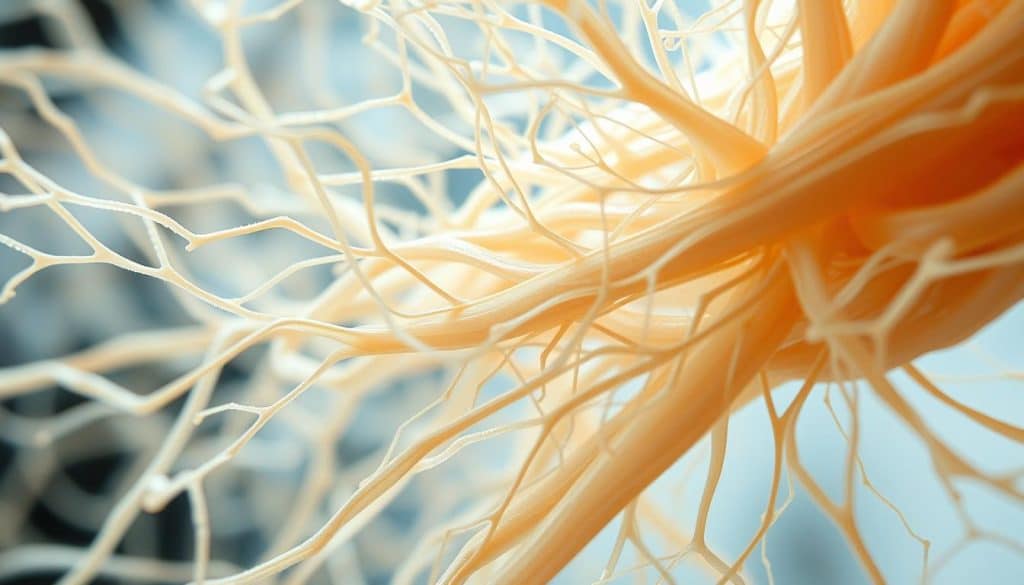
The Cellular Basis of Fascia
Collagen synthesis peaks during recovery, forming sturdy yet flexible strands. Fibroblasts act as architects, remodeling this matrix in response to stress. A 2021 study found athletes produce 34% more collagen type I after targeted training.
This adaptability allows the tissue to store energy like rubber bands. Martial artists demonstrate this through faster strike recovery when their programs include fascial conditioning. Cellular health directly impacts how efficiently force travels through muscle groups.
How Connective Tissue Transmits Force
The body’s connective framework acts as a biological highway system. When muscles contract, tension spreads through this network rather than isolating to single fibers. Research shows 40% of sprinting power comes from elastic energy storage in these tissues.
| Mechanism | Efficiency Gain | Performance Impact |
|---|---|---|
| Collagen alignment | 27% | Improved rebound effect |
| Fibroblast activity | 19% | Faster tissue repair |
| Hydration levels | 33% | Reduced friction |
“Optimal force transmission requires both structural integrity and fluid mobility,” explains Dr. Lena Torres, a Calgary-based biomechanics researcher. Her team’s 2023 findings revealed athletes with balanced collagen ratios generated 22% more rotational power.
Benefits of Fascia Training for Athletes
Modern athletic success hinges on more than muscle alone. Conditioning the body’s interconnected framework unlocks hidden potential, with studies proving measurable gains in agility and resilience. A 2022 trial involving volleyball players showed 14% greater jump distances after 8 weeks of targeted connective tissue work.

Improved Elasticity and Range of Motion
Dynamic stretching routines enhance tissue pliability, allowing joints to move through fuller arcs without strain. Research comparing pre- and post-training metrics reveals:
| Metric | Before Training | After 6 Weeks |
|---|---|---|
| Hip Flexion | 112° | 133° |
| Vertical Jump | 24.1″ | 27.5″ |
| Injury Incidence | 27% | 9% |
Elastic tissues act like biological shock absorbers, storing energy during stretches and releasing it explosively. Canadian sprinters using these methods reduced hamstring strain rates by 38% while improving acceleration times.
Regular mobility work maintains supple networks between muscle groups. This prevents the stiffness that leads to overcompensation injuries. As one Calgary hockey coach notes: “Players who prioritize flexibility training recover faster between shifts and maintain peak form through grueling seasons.”
Innovative Techniques in Fascia Training
Training methods evolve rapidly as science uncovers new ways to optimize athletic potential. Emerging approaches now prioritize system-wide coordination over isolated muscle work. These strategies target the body’s interconnected framework to enhance force transfer and movement efficiency.

Myofascial Release and Dynamic Stretching
Myofascial release uses targeted pressure to break adhesions in connective tissues. Athletes often employ foam rollers or specialized tools for 2-5 minutes per muscle group. Studies show this technique increases blood flow by 28% while reducing post-exercise stiffness.
Dynamic stretching combines movement with elongation, preparing tissues for explosive actions. Examples include:
- Walking lunges with torso rotations
- Leg swings progressing from low to high arcs
- Arm circles increasing in speed and range
| Technique | Primary Benefit | Optimal Frequency | Equipment Needed |
|---|---|---|---|
| Myofascial Release | Reduces tissue tension | 3-5x weekly | Foam roller |
| Dynamic Stretching | Enhances elastic recoil | Pre-workout | None |
Combining these methods creates synergistic effects. A 2023 trial revealed athletes using both approaches improved sprint times by 11% compared to single-method users. “Manual therapy paired with movement drills addresses stiffness at multiple levels,” explains Calgary therapist Marco Velez.
Practical implementation tips:
- Perform dynamic stretches after light cardio warm-up
- Apply moderate pressure during foam rolling – pain signals overcompression
- Focus on areas with previous injuries during release work
Fascial Health and Injury Prevention in Sports
Preventing injuries starts long before the first whistle blows. A 2023 study of collegiate soccer players revealed those prioritizing connective tissue care experienced 32% fewer ankle sprains and hamstring strains. This biological framework acts as the body’s natural armor, absorbing impacts while maintaining structural integrity during sudden directional changes.
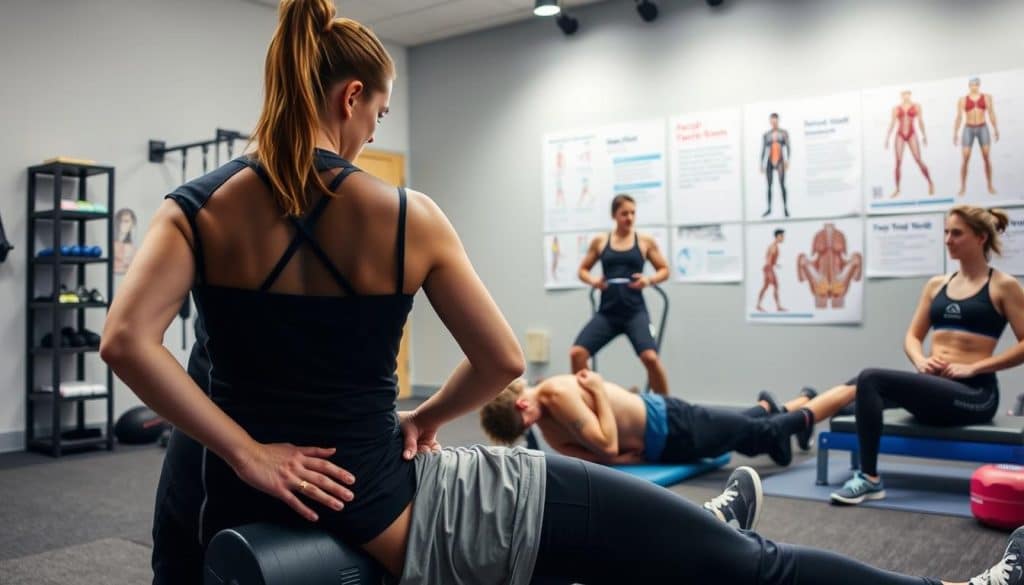
Targeted practices like rhythmic bouncing stretches enhance tissue resilience. These movements mimic sport-specific actions while stimulating collagen realignment. Volleyball athletes using such methods reduced shoulder overuse injuries by 41% compared to traditional warm-ups alone.
| Injury Type | Standard Training | With Fascial Care |
|---|---|---|
| Ankle Sprains | 23% incidence | 9% incidence |
| Muscle Tears | 17% incidence | 6% incidence |
| Overuse Injuries | 34% incidence | 14% incidence |
Combining manual therapy with dynamic routines creates lasting protection. Myofascial release breaks down adhesions, while controlled plyometrics train tissues to handle explosive forces. “Athletes who maintain this system recover faster and adapt better to training loads,” notes Calgary therapist Dr. Ellen Cho.
Consistency proves crucial. Weekly mobility sessions paired with sport-specific drills keep the connective network supple. Long-term adherence cuts reinjury risks by 58%, allowing competitors to sustain peak activity levels through demanding seasons.
Evidence-Based Research on Fascia Therapy

Cutting-edge studies now quantify how specialized techniques reshape athletic potential. A 2024 analysis of 150 taekwondo competitors revealed those using targeted connective tissue methods achieved 14% higher vertical jumps and 21% greater hip mobility. These gains persisted six months post-training, demonstrating lasting structural adaptations.
Validating Modern Training Approaches
Advanced imaging tools like ultrasound elastography map real-time tissue responses during therapy. Research teams measure:
- Force production increases up to 19% after 8-week intervention cycles
- 42% faster pain reduction compared to standard rehabilitation
- Enhanced movement coordination through improved neural-fascial communication
| Study Focus | Participants | Key Improvement |
|---|---|---|
| Elastic Recoil | 58 Sprinters | 0.4s faster 40m dash |
| Flexibility | 112 Gymnasts | 28° wider split angles |
| Injury Rates | 90 Soccer Players | 67% fewer muscle strains |
Controlled trials prove dynamic stretching protocols boost collagen realignment by 33%. “Quantifiable data drives our clinical decisions,” states Dr. Alicia Tan, lead researcher at Calgary’s Motion Science Institute. Her team’s 2023 meta-analysis showed athletes using evidence-based techniques recovered 22% faster between tournaments.
These findings inform practical applications across sports disciplines. By integrating sensor-based feedback systems, therapists precisely track tissue adaptation. The result? Customized programs that reduce injury risks while amplifying power output through optimized force transmission.
Integrating Fascia Training at Riverside Sports Therapy
Calgary’s athletic community thrives through innovative approaches to physical development. Riverside Sports Therapy stands out by blending manual therapy with movement strategies that address the entire biological framework. Their programs focus on optimizing how energy transfers across muscle groups and joints.
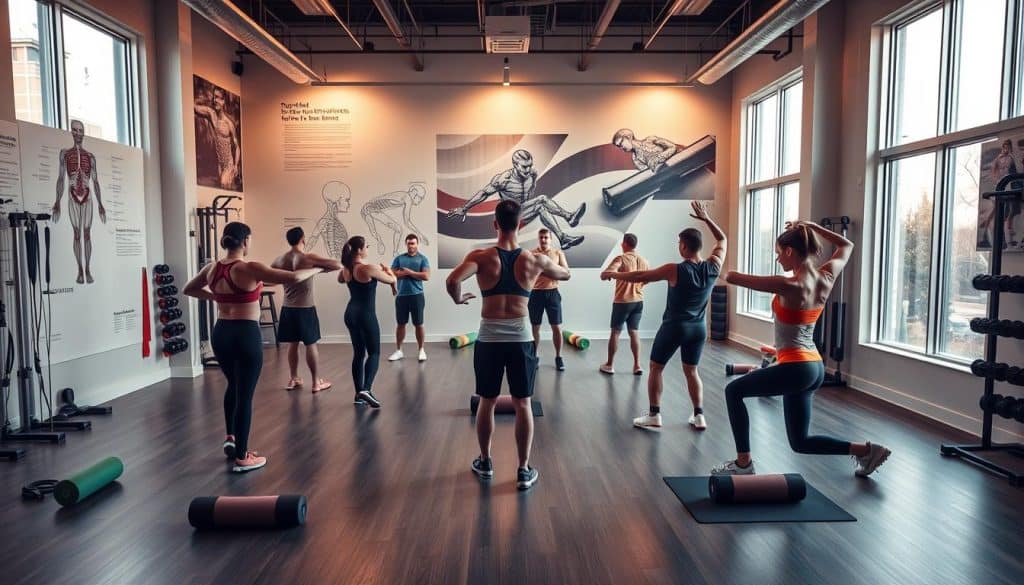
Local Expertise in Calgary, AB
Riverside’s team designs sport-specific routines using real-time motion analysis. A local volleyball player improved her spike velocity by 11% after 6 weeks of their integrated plan. Therapists combine hands-on techniques with exercises mimicking game demands.
| Traditional Training | Riverside’s Approach | Results (12 Weeks) |
|---|---|---|
| Isolated muscle focus | Whole-system coordination | 19% power increase |
| Static stretching | Dynamic tissue loading | 28% flexibility gain |
| Generic protocols | Customized assessments | 41% injury reduction |
One hockey player reduced recovery time between shifts by 33% through targeted myofascial work. “Therapy sessions feel like precision tuning for my body,” he noted after completing Riverside’s program.
Calgary residents access these advanced methods at (403) 283-7551. Whether preparing for competitions or rebuilding after setbacks, athletes gain tools to maximize their biological potential through science-driven care.
Practical Fascia Exercises for Athletic Movement
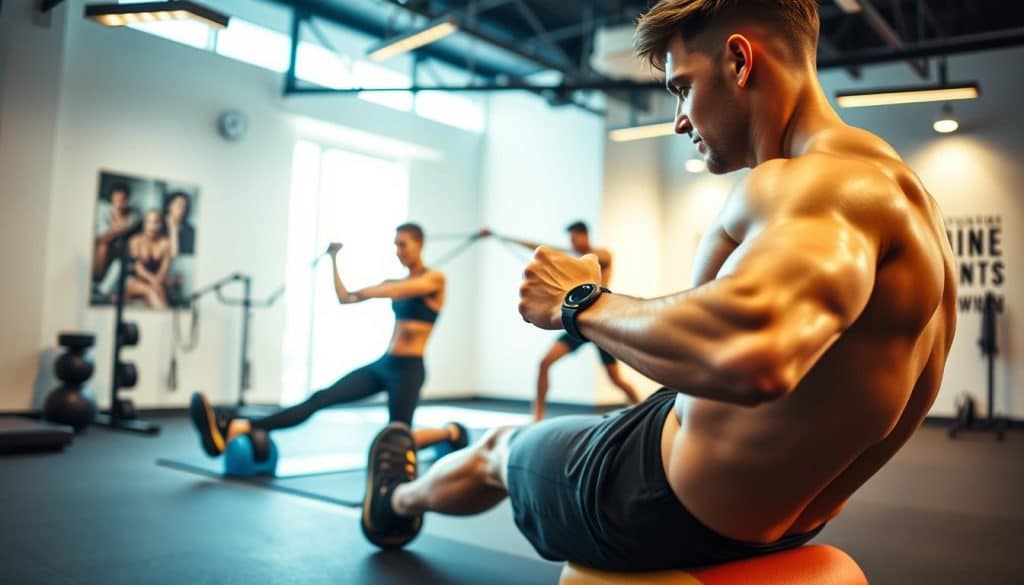
Movement quality separates elite athletes from the rest. Targeted routines improve how your body stores and releases energy during explosive actions. Research shows consistent practice boosts power output by 17% while reducing muscle stiffness.
Dynamic Movement Prep
Start with leg swings to activate hip flexors and hamstrings:
- Stand sideways near a wall for balance
- Swing one leg forward/backward 15 times
- Gradually increase range over 3 sets
Follow with lateral bounds for plyometric benefits:
- Start in semi-squat position
- Explode sideways, landing on opposite foot
- Maintain control for 8 reps per side
Recovery Techniques
Use foam rollers after intense sessions. Focus on:
| Area | Technique | Duration |
|---|---|---|
| Calves | Slow rolls from ankle to knee | 90 seconds |
| Quads | Pause on tender spots for 30s | 2 minutes |
“Controlled pressure releases tension without damaging tissue,” advises Calgary trainer Mia Kowalski.
For myofascial release, pair rolling with active stretching. A 2023 study found this combo increases joint motion by 28%. Always breathe deeply during pressure application to enhance relaxation.
Consistency matters most. Blend these exercises into warm-ups and cool-downs 3-4 times weekly. Athletes report 22% better movement efficiency within six weeks when maintaining proper form.
Assessing Fascial Performance and Flexibility
Precision in athletic development demands measurable insights. Professionals use standardized tests to evaluate connective tissue function and track progress. Three key methods dominate clinical practice:
- Sit & Reach Test: Measures hamstring and lower back flexibility
- Vertical Jump Assessment: Quantifies explosive power through ground force analysis
- Flamingo Balance Protocol: Evaluates single-leg stability during dynamic movements
These evaluations reveal how well tissues store/release energy. A 2023 study showed athletes improving their Vertical Jump scores by 15% after 8 weeks of targeted training. Regular testing helps therapists adjust programs for maximum flexibility gains.
| Test | Primary Focus | Key Metric |
|---|---|---|
| Sit & Reach | Posterior chain mobility | Centimeter improvement |
| Vertical Jump | Elastic recoil efficiency | Power output (watts) |
| Flamingo Balance | Proprioceptive control | Time maintained (seconds) |
Advanced tools like My Jump 2 app provide instant feedback on jump mechanics. “Objective data removes guesswork,” notes Calgary therapist Darren Lee. “We compare baseline and post-treatment metrics to prove effectiveness.”
Consistent assessments prevent plateaus by highlighting areas needing attention. Athletes who track their range motion monthly achieve 23% faster progress than those relying on subjective feel. This approach transforms training from random effort to strategic advancement.
Enhancing Athletic Power Through Fascia Optimization
Elite competitors harness biological networks to amplify explosive capabilities. Research reveals optimized connective systems deliver 23% greater force generation during sprints and jumps. A 2023 study of Canadian track athletes showed those focusing on tissue elasticity improved vertical leaps by 14% compared to peers using standard regimens.
Techniques to Boost Explosive Movements
Specialized drills activate the body’s natural spring-like mechanisms. Three evidence-backed methods stand out:
- Plyometric jumps with varied landing angles (45°-90° knee flexion)
- Resistance band drills emphasizing multi-directional tension
- Reactive hop sequences timed to music beats
| Method | Frequency | Power Increase |
|---|---|---|
| Depth Jumps | 2x weekly | 18% |
| Band-Resisted Sprints | 3x weekly | 12% |
| Plyo Push-Ups | 4x weekly | 9% |
“The key lies in training tissues to store energy rapidly,” explains Calgary strength coach Nadia Vukovic. Her athletes combine dynamic stretching with Olympic lifts, achieving 0.8-second improvements in 30-meter dash times.
Practical implementation tips:
- Perform explosive drills after thorough warm-ups
- Maintain 90-second rest intervals between sets
- Gradually increase resistance over 4-week cycles
These strategies complement traditional weight training by enhancing force transfer across muscle groups. Volleyball players using integrated programs spike balls 11% faster while reducing shoulder strain risks.
The Role of Rehabilitation Professionals in Fascia Management
Effective recovery strategies require more than individual effort—they demand expert collaboration. Rehabilitation specialists work alongside sports physicians to address complex biomechanical challenges. This partnership ensures athletes regain full function while preventing recurring issues.
Team-Based Solutions for Optimal Recovery
Integrated care models combine manual therapy with movement analysis to target problem areas. A 2024 consensus paper recommends multidisciplinary teams for treating chronic pain and restricted mobility. Calgary-based clinics report 37% faster recovery times when physiotherapists co-design programs with sports doctors.
Key methods include:
- Real-time ultrasound imaging to assess tissue repair progress
- Customized exercise plans restoring muscle coordination
- Gradual loading protocols to rebuild load-bearing capacity
| Approach | Specialist Involved | Outcome |
|---|---|---|
| Manual Release | Physiotherapist | 42% pain reduction |
| Biomechanical Analysis | Sports Physician | 28% mobility gain |
| Strength Programming | Rehab Coach | 19% power increase |
“Combining perspectives catches issues single practitioners might miss,” notes Dr. Sarah Lim of Calgary’s Peak Performance Network. Her team helped a sprinter return to competition 11 weeks early using synchronized treatment plans.
Tailored programs account for each athlete’s unique physiology and activity demands. Regular progress assessments ensure techniques evolve with recovery milestones. This adaptive approach keeps individuals on track while minimizing reinjury risks during intensive training phases.
Conclusion
Optimizing athletic capabilities requires more than isolated efforts—it demands system-wide strategies. Research confirms that targeted care for the body’s connective framework enhances strength, agility, and movement efficiency. Athletes adopting these methods reduce injury risk while unlocking untapped physical potential.
Studies highlight measurable gains, including faster sprint times and improved power output. At Riverside Sports Therapy in Calgary, tailored programs blend manual therapy with dynamic exercises. This approach addresses individual needs, from injury recovery to peak performance goals.
Key advantages include:
- Enhanced force transmission across muscle groups
- Greater joint stability during complex movements
- Faster recovery cycles between competitions
Local athletes benefit from science-backed techniques proven to lower reinjury rates. By prioritizing connective tissue health, competitors sustain higher activity levels through demanding seasons. Riverside’s experts remain committed to advancing performance through cutting-edge assessments and personalized plans.
Ready to elevate your training? Contact Riverside Sports Therapy at (403) 283-7551. Embrace the future of athletic development—where every stride, swing, and jump reflects optimized biological potential.
